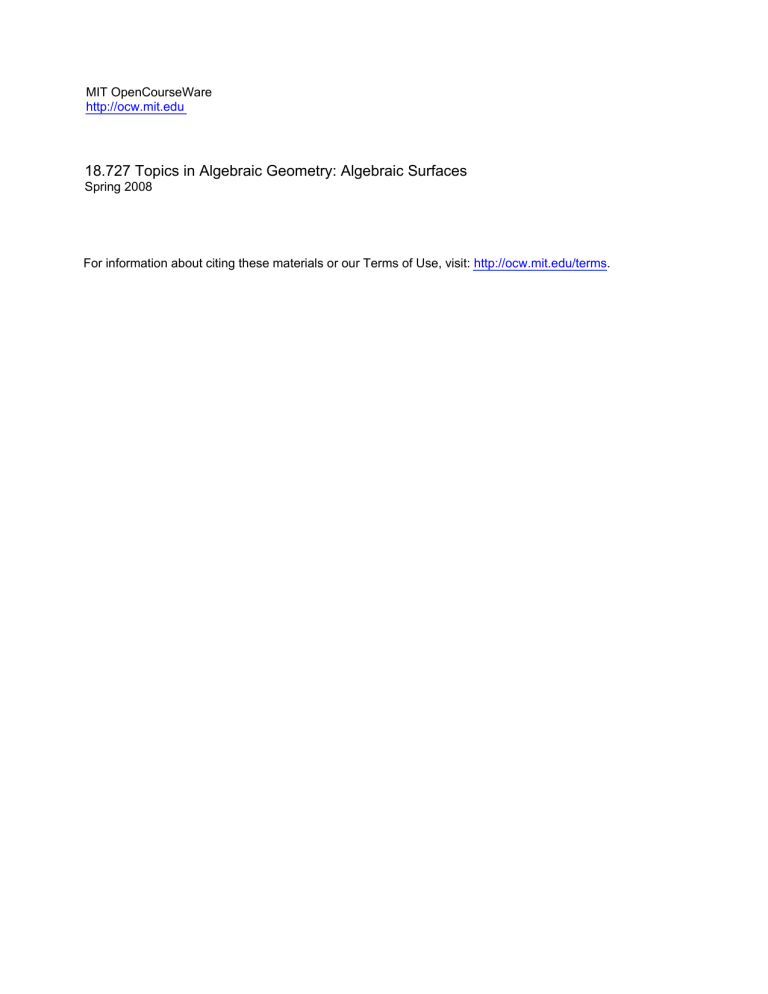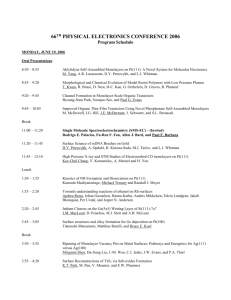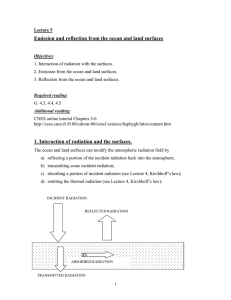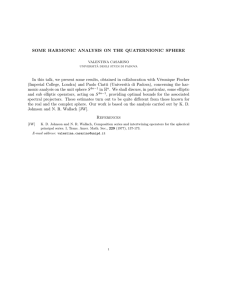18.727 Topics in Algebraic Geometry: Algebraic Surfaces MIT OpenCourseWare .
advertisement

MIT OpenCourseWare http://ocw.mit.edu 18.727 Topics in Algebraic Geometry: Algebraic Surfaces Spring 2008 For information about citing these materials or our Terms of Use, visit: http://ocw.mit.edu/terms. ALGEBRAIC SURFACES, LECTURE 22-23 LECTURES: ABHINAV KUMAR 1. Classification (contd.) Recall the classification from before: (a) ∃ an integral curve C on X s.t. K · C < 0. (b) K ≡ 0. (c) K 2 = 0, K · C ≥ 0 for all integral curves C, and ∃C � s.t. K · C � > 0. (d) K 2 > 0, and K · C ≥ 0 for all integral curves C. Theorem 1. Let X be a minimal surface in class (b) or (c). Then p4 > 0 or p6 > 0. So, if X belongs to class (b), then 4K ∼ 0 or 6K ∼ 0, and if X belongs to class (c), then |4K| or |6K| contains a strictly positive divisor. Proof. If X is in class (b) or (c), then K 2 = 0, K · C ≥ 0 for any integral curve C. Thus, either 2K ∼ 0 or X has an elliptic/quasielliptic fibration. If 2K ∼ 0, then of course K ≡ 0, implying that X is in class (b) and p2 �= 0 =⇒ p4 , p6 �= 0 as well. Otherwise, let f : X → B be the stated fibration, and assume that pg = 0 (if pg = p1 > 0, then pn > 0 for all n ≥ 2 and the theorem holds). Now, for X minimal with K 2 = 0, pg = 0, we have that pg = h0 (B, L−1 ⊗ ωB ) = 0 and deg (L−1 ⊗ ωB ) = 2pa (B) − 2 + χ(OX ) + �(T ). But χ(OX ) ≥ 0 from the list of last time, so by Riemann-Roch, pa (B) = 1, χ(OX ) = 0, �(T ) = 0 or pa (B) = 0, χ(OX ) + �(T ) < 2. We analyze these two cases separately. Case 1: having no exceptional fibers implies that ai = mi − 1 for all i. If ∃ a multiple fiber mi Pi with mi ≥ 2, then (say m1 ≥ 2) � ωX = f ∗ (L−1 ⊗ ωB ) ⊗ OX ( (mi − 1)Pi ) � (1) 2 ωX = f ∗ (L−2 ⊗ ωB2 ) ⊗ OX ( (2mi − 2)Pi ) ⊗ f ∗ OB (b1 ) ⊗ OX ((m1 − 2)P1 ) i>1 Since deg (L−2 ⊗ωB2 ⊗OB (b1 ) ≥ 1 and B is an elliptic curve, p2 ≥ 1 and so p4 , p6 > 0, proving the theorem. If f has no multiple fibers, then ωX = f ∗ (L−1 ⊗ ωB ), and deg (L−1 ⊗ ωB ) = 2pa (B) − 2 + χ(OX ) + �(T ) = 0 =⇒ ωX ≡ 0 and thus X is in class (b). It also must be case 5 from last time, thus giving a bielliptic surface and another elliptic fibration g : X → P1 , placing it in case 2 of our analysis. 1 2 LECTURES: ABHINAV KUMAR Case 2: pa (B) = 0, i.e. B = P1 , pg = 0, i.e. deg (L−1 ⊗ ωB ) = −2 + χ(OX ) + �(T ) < 0. Now, � ai ≥0 λ(f ) = −2 + χ(OX ) + �(T ) + (2) mi and an easy check gives � � nai � 0 h (nK) = 1 + n (−2 + χ(OX ) + �(T )) + (3) mi Case 2A: �(T ) = 0, so ai = mi − 1 for all i. Also, −2 + χ(OX ) + �(T ) < 0 gives = 0, then we must have at least 3 multiple fibers χ(OX ) = 0, 1. If χ(OX ) � mi −1 ≥ 0. (because we need −2 + mi – ≥ 4 multiple fibers, mi ≥ 2. Then check |2K| = � ∅, i.e. p2 > 0. � ∅, so p3 , p6 > 0. – 3 multiple fibers, all mi ≥ 3. Then |3K| = – 3 multiple fibers, m1 = 2, m2 , m3 ≥ 4 =⇒ |4K| �= ∅. – 3 multiple fibers, m1 = 2, m2 = 3, m3 ≥ 6 =⇒ |6K| = � ∅. Case 2B: �(T ) = 1, i.e. there is exactly one wild/exceptional fiber F . Now −2 + χ(OX ) + �(T ) < 0 =⇒ χ(OX ) = 0. Also, pg = 0 =⇒ q = 1. Applying the corollary from the previous lecture, we get a1 = m1 −1 or m� 1 − 1 − α1 , ai ≥ 0, where α1 is a common divisor of m1 and a1 + 1. Since −1 + mi there are at least 2 multiple fibers, so either – There exist at least 2 multiple curves with ai = mi − 1, so |2K| = � ∅. � ∅. – F has m1 = 3, a1 = 1, α1 = 1, m2 ≥ 3 =⇒ |3K | = – F has m1 = 4, a1 = 1, α1 = 2, m2 ≥ 4 =⇒ |4K| = � ∅. a1 1 ≥ =⇒ | 2 K| = � ∅. – F has m1 = β1 α1 , β1 ≥ 4 =⇒ m 2 1 – F has m1 = 2α1 , a1 = α1 − 1, α1 ≥ 3, m2 ≥ 3 =⇒ |3K | = � ∅. � ∅. – F has m1 = 3α1 , a1 = 2α1 − 1, α1 ≥ 2, m2 ≥ 2 =⇒ |2K| = This concludes the proof. � So for X a minimal surface with elliptic/quasielliptic fibration f : X → B, • X is in (a) ⇔ λ(f ) < 0 ⇔ κ(X) = −∞ ⇔ pn = 1∀n ≥ 1 ⇔ p4 = p6 = 0 ⇔ p12 = 0, • X is in (b) ⇔ λ(f ) = 0 ⇔ κ(X) = 0 ⇔ nK ∼ 0 for some n ≥ 1 ⇔ 4K ∼ 0 or 6K ∼ 0 ⇔ 12K ∼ 0, • X is in (c) ⇔ λ(f ) > 0 ⇔ κ(X) = 1 ⇔ nK has a strictly positive divisor for some n ≥ 1 ⇔ |12K| has a strictly positive divisor. Theorem 2. Let X be a minimal surface in class (d), i.e. K 2 > 0, K · C ≥ 0 for all curves C on X. Then |2K| = � ∅, and for sufficiently large n, the linear system |nK| is free of base points and defines a morphism φn = φ|nK| : X → P(H 0 (OX (nK))∨ ) s.t. • Xn = φn (X) is normal, with at most rational double points as singu­ larities, i.e. desingularizing gives a fixed cycle Z (the smallest divisor ALGEBRAIC SURFACES, LECTURE 22-23 3 with support in the exceptional locus with Z · Ei ≤ 0 ∀ i) which satisfies pa (Z) = 0, Z 2 = −2. • φn is an isomorphism away from the singular locus, i.e. (4) ∼ X � φ−1 n (Sing(Xn )) → Xn � Sing(Xn ) In this case, κ(X) = 2. Proof. Exercise. Use Riemann-Roch, the Hodge index theorem, and NakaiMoishezon. The point is that if K · C > 0 for all integral curves C on X, then K is ample and we’re through. So the problem comes from curves Ei s.t. K · Ei = 0. But K 2 > 0 and on the orthogonal complement of K, the form (·) is negative definite, so there at most finitely such curves Ei . Show that they are � rational (pa (Ei ) = 0), and satisfy the criteria of rational double points. There are some things left to prove in classification: one is that every minimal surface with κ(X) = 0, b2 = 6 is Abelian (see Bombieri-Mumford). Remark. For a surface of general type, |nK| is base point free for n ≥ 4, and for n ≥ 5, φ|nK| is an isomorphism away from the union of finitely many rational curves. To review, we have shown that, if X is a minimal surface and f : X → B is an elliptic/quasi-elliptic fibration, then • X is in (a) iff λ(f ) < 0 ⇔ κ(X) = −∞ ⇔ |4K | = |6K | = ∅, • X is in (b) iff λ(f ) = 0 ⇔ κ(X) = 0 ⇔ 4K ∼ 0 or 6K ∼ 0, • X is in (c) iff λ(f ) > 0 ⇔ κ(X) = 1 ⇔ |4K| or |6K| contain strictly positive divisors, and K 2 = 0. • X is in class (d) ⇔ κ(X) = 2, and in this case |2K| = ∅. Since (a),. . .,(d) are mutually disjoint and exhaustive, we get the following the­ orem: Theorem 3. Let X be a minimal surface. Then: • ∃C > 0 on X s.t. K · C < 0 ⇔ κ(X) = −∞ ⇔ p4 = p6 = 0 ⇔ p12 = 0 ⇔ X is ruled. • K ≡ 0 ⇔ κ(X) = 0 ⇔ 4K ∼ 0 or 6K ∼ 0 ⇔ 12K ∼ 0 ⇔ X is abelian, K3, Enriques, or bielliptic, • K 2 = 0, K · C ≥ 0 ∀ C integral, and K · C � > 0 for some C ⇔ κ(X) = 1 ⇔ K 2 = 0 and |4K| or |6K| contain strictly positive divisors ⇔ X is honestly elliptic. • K 2 > 0, K · C ≥ 0 ∀ C > 0 ⇔ κ(X) = 2, and in this case |2K| = ∅. Such a surface is one of general type. Example. Examples of general type surfaces: (1) C1 × C2 where C1 , C2 are smooth projective curves of genus ≥ 2. 4 LECTURES: ABHINAV KUMAR (2) Smooth, complete . . , fn−2 in Pn of degree �intersections cut out by f1 , .� d1 , . . . , dn−2 s.t. di > n + 1 (then ωX = OX ( di − n − 1) is ample). Such a surface also has q = 0. (3) Godeaux surface, i.e. a quotient of a Fermat surface. For instance, x5 + y 5 + z 5 + t5 = 0 in P3 quotiented by Z/5Z acting as (5) σ(z, y, z, t) = (x, ζy, ζ 2 z, ζ 3 t) for a generator ζ of Z/5Z. There are no fixed point, and the quotient as q = pg = 0 but not p2 = 0, and it is of general type (K 2 = 15 5 = 1). Remark. Here are various results for surfaces we did not cover here: • Castelnuovo’s inequality: for a non-ruled surface X, χtop (X) ≥ 0, χ(OX ) ≥ 0. If X is of general type, then χ(OX ) > 0, χtop (X) ≥ 0 is equivalent to K 2 ≤ 12χ(OX ). • Bogomolov-Miyaoka-Yau inequality (conjectured by the first two, proved by Yau): K 2 ≤ 9χ(OX ). • Persson: All values for K 2 ≤ 8χ actually occur. • Mumford, Hirzebruch: ∃ surfaces for which K 2 = 9χ(OX ). 2. Moduli First, in the case of κ = −∞, we have surfaces ruled over a curve C, whose moduli we can study by studying vector bundles of rank 2 on C. One finds that for g ≥ 2, there are 3g − 3 moduli (coming from stable vector bundles). Over P1 , the moduli are a discrete set of points (the Hirzebruch surfaces Fn or Σn ). Over an elliptic curve, any rank 2 vector bundle is either decomposable, the extension of OC by OC , or the extension of OC (p) by OC for p ∈ E. Next, for κ = 0, we have different moduli depending on the subcategorization. For abelian surfaces with polarization, there exist Siegel modular varieties coming from quotienting by a discrete subgroup of the symplectic group. For K3 surfaces (marked and with polarization), one obtains a moduli space as an open subset of a quadric in CP20 (a bounded, symmetric domain of type IV). Moding out by the marking, one obtains a quotient by a discrete subgroup of the orthogonal. Similarly, one obtains algebraic varieties characterising the moduli for Enriques surfaces. Lastly, for hyperelliptic and bielliptic surfaces, our previous explicit description allows one to describe the moduli relatively easily. Then, for honestly elliptic surfaces, one can describe the moduli either by functional and homological invariants, or by the Weierstrass equations. For surfaces of general type, however, little is known.




